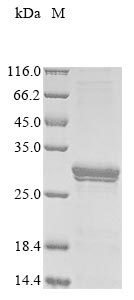Recombinant Mouse Protein canopy homolog 2 (Cnpy2) is produced in an E.coli expression system and contains the full length of the mature protein, spanning amino acids 21 to 182. This protein features an N-terminal 10xHis-tag and a C-terminal Myc-tag, which makes purification and detection more straightforward. With a purity level exceeding 85% as determined by SDS-PAGE, this product appears well-suited for various research applications requiring high-quality reagents.
Canopy homolog 2 (Cnpy2) is a protein involved in various cellular processes. It likely plays a significant role in the regulation of signaling pathways, though the exact mechanisms may still be under investigation. As a part of the canopy family, Cnpy2 is studied for its involvement in protein folding and cellular homeostasis. Its functional relevance and interactions make it a valuable subject in research focused on cellular signaling mechanisms.
Potential Applications
Note: The applications listed below are based on what we know about this protein's biological functions, published research, and experience from experts in the field. However, we haven't fully tested all of these applications ourselves yet. We'd recommend running some preliminary tests first to make sure they work for your specific research goals.
1. Protein-Protein Interaction Studies Using Pull-Down Assays
The dual-tagged recombinant mouse Cnpy2 protein with N-terminal His-tag and C-terminal Myc-tag provides useful tools for investigating protein-protein interactions. The His-tag allows immobilization on nickel-based resins for pull-down experiments to identify potential binding partners from mouse cell lysates or tissue extracts. Meanwhile, the Myc-tag enables detection and validation of interactions through Western blotting or immunoprecipitation approaches. This application could be valuable for mapping the interactome of Cnpy2 in mouse cellular systems, though results may require careful validation.
2. Antibody Development and Validation
The purified recombinant mouse Cnpy2 protein (21-182aa) representing the full-length mature protein can serve as an immunogen for generating specific antibodies against mouse Cnpy2. The high purity (>85%) suggests minimal contamination that could lead to cross-reactive antibodies. The dual tags also provide internal controls for antibody specificity testing, as researchers can verify that developed antibodies recognize the native protein rather than the tags. Generated antibodies could then be used for various downstream applications including Western blotting, immunofluorescence, and immunohistochemistry in mouse models.
3. Biochemical Characterization and Structural Studies
The recombinant protein provides a standardized source for investigating the biochemical properties of mouse Cnpy2. This includes thermal stability, pH sensitivity, and cofactor requirements. The dual-tag system aids protein purification and detection during various analytical procedures such as size exclusion chromatography, dynamic light scattering, or analytical ultracentrifugation. These studies could provide fundamental insights into the protein's biophysical characteristics and potentially inform future functional studies, though interpretation may depend on how well the recombinant protein reflects native protein behavior.
4. ELISA Development for Quantitative Detection
The dual-tagged recombinant mouse Cnpy2 can be used to develop sandwich or competitive ELISA assays for quantitative detection of endogenous Cnpy2 in mouse biological samples. The His-tag enables direct coating onto nickel-coated plates, while the Myc-tag provides a detection epitope for assay development. This application would be particularly useful for researchers studying Cnpy2 expression levels across different mouse tissues, developmental stages, or experimental conditions in research settings. However, assay optimization may be needed to achieve reliable quantitative results.




